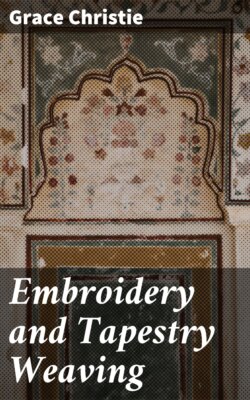Читать книгу Embroidery and Tapestry Weaving - Grace Christie - Страница 11
На сайте Литреса книга снята с продажи.
SATIN AND SIMILAR STITCHES
ОглавлениеSatin stitch is perhaps the most commonly used of all stitches. It is more quickly worked by hand, but for complicated work the help of a frame is required. Floss silk thread is seen to greatest advantage in a stitch of this kind, for it shows off the glossiness of silk particularly well. It is straightforward in the working and needs no further description than is given by the diagram (fig. 39). The stitches may vary in length, they must neither be impracticably long nor, on the other hand, too much cut up, lest the silky effect be partly lost. These stitches lie close together and in parallel lines; the chief difference between satin and several other closely allied stitches being that these others may radiate or vary in direction according to the space to be filled. The stitch is usually worked in oblique lines; stems, leaves, and petals would be treated in this way; sometimes it is worked regularly having regard to the warp and woof of the material; it would be treated thus when used in conjunction with cross or stroke stitch.
Fig. 39.
It will be seen that there is as much silk at the back as on the front of the work. There is a method of carrying out the stitch by which this waste of material at the back is avoided; the thread is returned to the front close to where it went through instead of crossing over and coming up on the other side. The effect on the right side, however, is not so good, so this method cannot be recommended.
One of the technical difficulties with satin stitch is to get a neat firm line at the edges of the filled space; this is excellently attained by the Chinese and Japanese, who use this satin stitch a great deal. They frequently work each petal of a complicated flower separately, leaving as a division, between each one and the next, a fine line of material firmly and clearly drawn.
Fig. 40.
The stitch is much used for raised work, and also lends itself well to gradation of colour. Fig. 40 is an example of shading in satin stitch. In this case each new row of stitches fits in just between those of the last row; this is a bold but very effective method of expressing gradation. A variation upon this is shown in fig. 42; the bands of different colour are here necessarily worked in a chevron pattern which makes the shading rather more gradual. An example of the same thing can be seen in fig. 44 in the leaf upon which the squirrel sits. Apart from gradation of colour, the surface to be covered by satin stitch has often to be partitioned up in some way in order to make the satin stitches of a practical length.
Fig. 41.
Long and short stitch is a very slight variation, if any, from satin stitch. The name describes the method of working, for it is carried out by working alternately a long and a short stitch, the stitches being picked up just as in satin stitch. It is useful for close fillings and shaded work, and also as a solid outline for any kind of open filling. The working of the stitch can be seen in fig. 41, where the band of lightest colour on the upper part of the leaf is worked in long and short stitch. The advantage of this way of working can be seen at once, it makes a firm outline on the one edge and a nicely broken-up one on the other, just ready for another shade to be worked in. In order to carry out the rest of the shading on the leaf in the same way the stitches can be all of the same length; this will always ensure a broken line at the edge, which is a necessity for this method of gradation. Long and short stitch used as an outline for a leaf with an open filling can be seen on page 209. The opus plumarium or feather stitch that we read of in the descriptions of the old embroideries was a similar stitch to this, and so called, some say, because it resembled the plumage of a bird.
